Strategic Management: Alternative Approaches and Organizational Impact
VerifiedAdded on 2023/03/17
|19
|3824
|86
Report
AI Summary
This report provides an in-depth analysis of alternative strategic management approaches, examining their history, benefits, limitations, and practical applications. The report focuses on three key approaches: Stakeholder strategic management, Dynamic capabilities strategic management, and the Resource-Based View (RBV) approach. It explores how Coca-Cola utilizes the Stakeholder approach to manage relationships with various stakeholders, Apple leverages Dynamic Capabilities for innovation, and Toyota employs the RBV model to maintain a competitive edge. The report highlights the importance of each approach in achieving organizational objectives, enhancing performance, and gaining a competitive advantage. It also discusses the advantages and disadvantages of each approach, emphasizing that the choice of approach depends on factors such as product, market conditions, and management preferences. The report concludes by emphasizing that while each approach has its unique characteristics, they often share common operational benefits, such as the efficient utilization of resources.
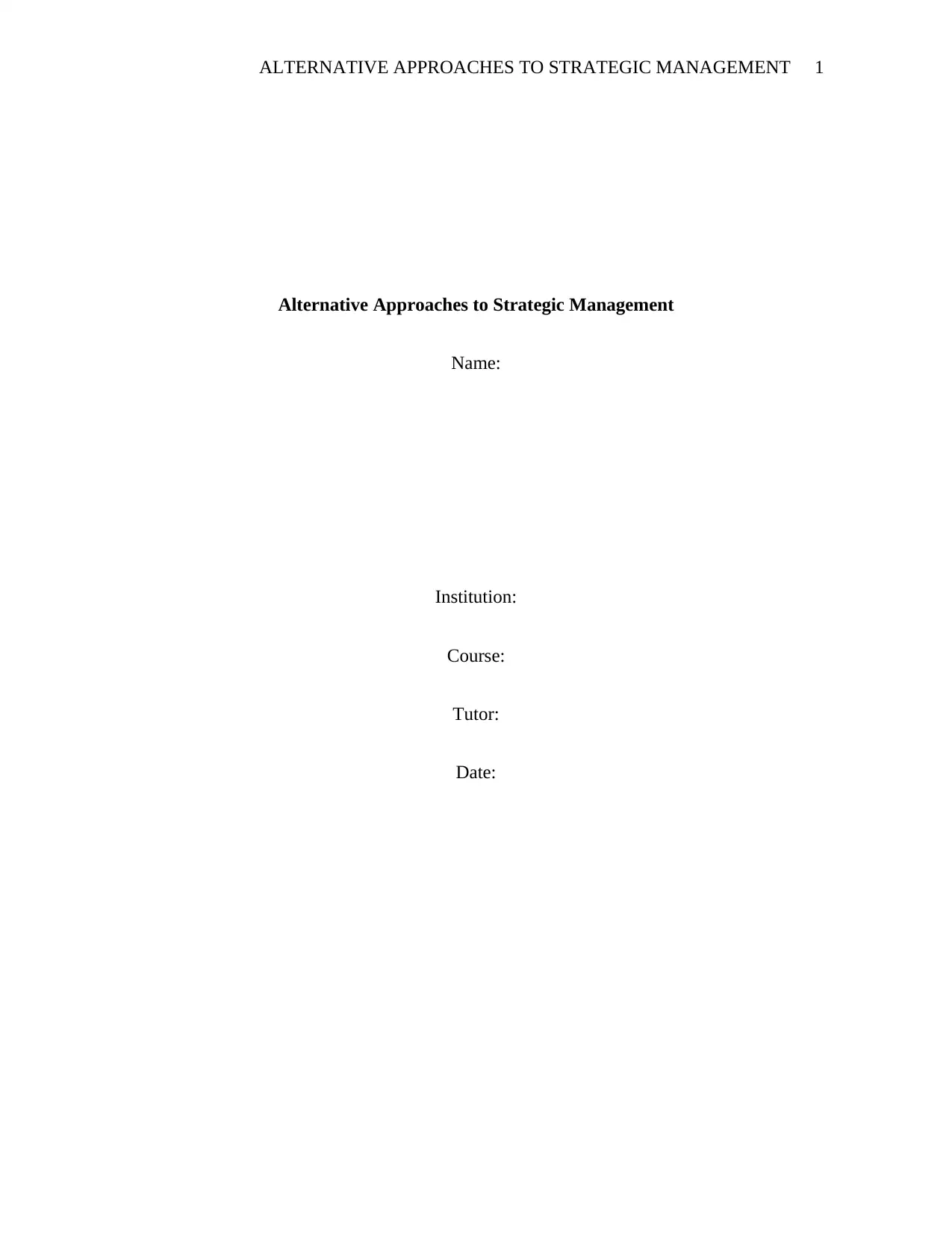
ALTERNATIVE APPROACHES TO STRATEGIC MANAGEMENT 1
Alternative Approaches to Strategic Management
Name:
Institution:
Course:
Tutor:
Date:
Alternative Approaches to Strategic Management
Name:
Institution:
Course:
Tutor:
Date:
Paraphrase This Document
Need a fresh take? Get an instant paraphrase of this document with our AI Paraphraser
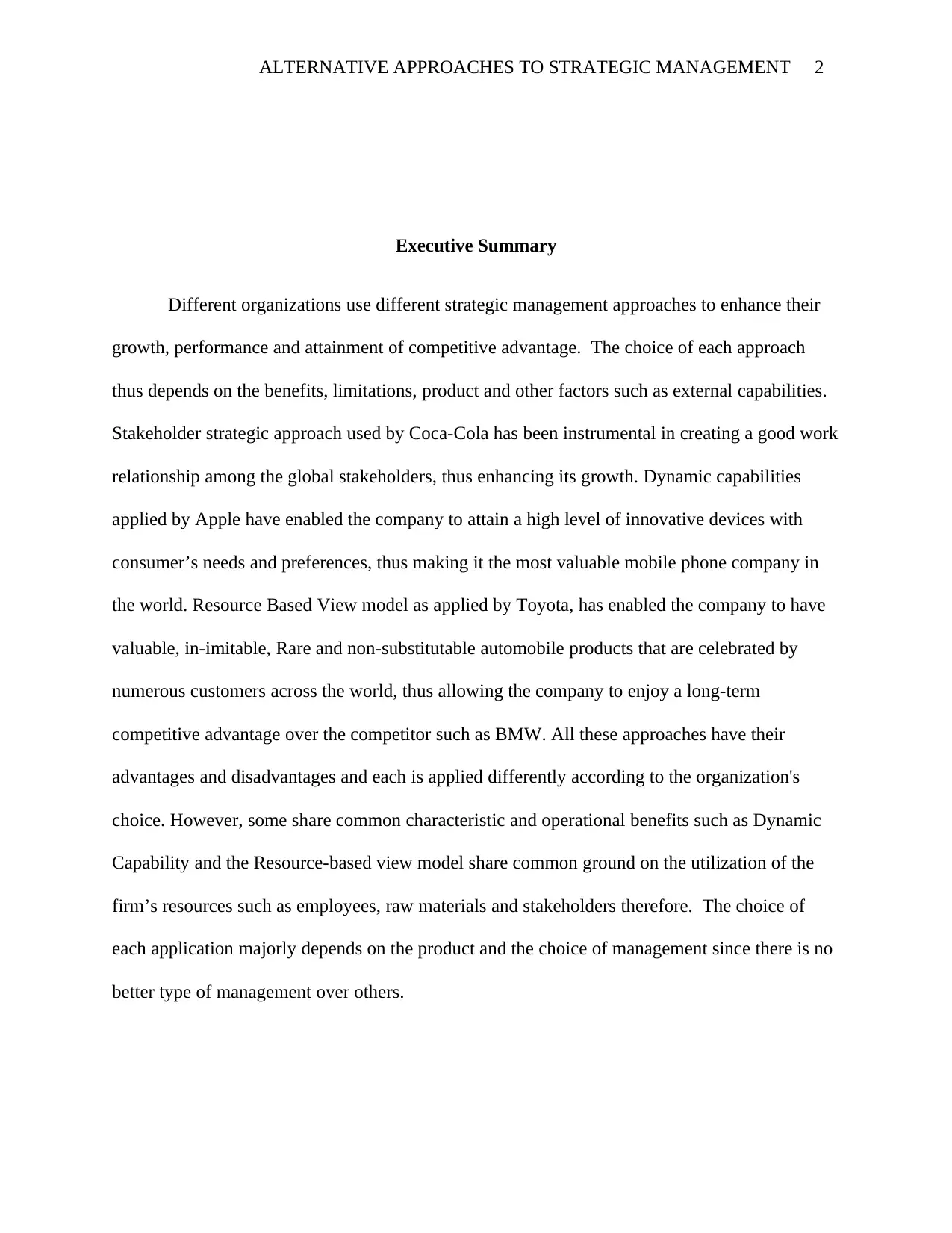
ALTERNATIVE APPROACHES TO STRATEGIC MANAGEMENT 2
Executive Summary
Different organizations use different strategic management approaches to enhance their
growth, performance and attainment of competitive advantage. The choice of each approach
thus depends on the benefits, limitations, product and other factors such as external capabilities.
Stakeholder strategic approach used by Coca-Cola has been instrumental in creating a good work
relationship among the global stakeholders, thus enhancing its growth. Dynamic capabilities
applied by Apple have enabled the company to attain a high level of innovative devices with
consumer’s needs and preferences, thus making it the most valuable mobile phone company in
the world. Resource Based View model as applied by Toyota, has enabled the company to have
valuable, in-imitable, Rare and non-substitutable automobile products that are celebrated by
numerous customers across the world, thus allowing the company to enjoy a long-term
competitive advantage over the competitor such as BMW. All these approaches have their
advantages and disadvantages and each is applied differently according to the organization's
choice. However, some share common characteristic and operational benefits such as Dynamic
Capability and the Resource-based view model share common ground on the utilization of the
firm’s resources such as employees, raw materials and stakeholders therefore. The choice of
each application majorly depends on the product and the choice of management since there is no
better type of management over others.
Executive Summary
Different organizations use different strategic management approaches to enhance their
growth, performance and attainment of competitive advantage. The choice of each approach
thus depends on the benefits, limitations, product and other factors such as external capabilities.
Stakeholder strategic approach used by Coca-Cola has been instrumental in creating a good work
relationship among the global stakeholders, thus enhancing its growth. Dynamic capabilities
applied by Apple have enabled the company to attain a high level of innovative devices with
consumer’s needs and preferences, thus making it the most valuable mobile phone company in
the world. Resource Based View model as applied by Toyota, has enabled the company to have
valuable, in-imitable, Rare and non-substitutable automobile products that are celebrated by
numerous customers across the world, thus allowing the company to enjoy a long-term
competitive advantage over the competitor such as BMW. All these approaches have their
advantages and disadvantages and each is applied differently according to the organization's
choice. However, some share common characteristic and operational benefits such as Dynamic
Capability and the Resource-based view model share common ground on the utilization of the
firm’s resources such as employees, raw materials and stakeholders therefore. The choice of
each application majorly depends on the product and the choice of management since there is no
better type of management over others.
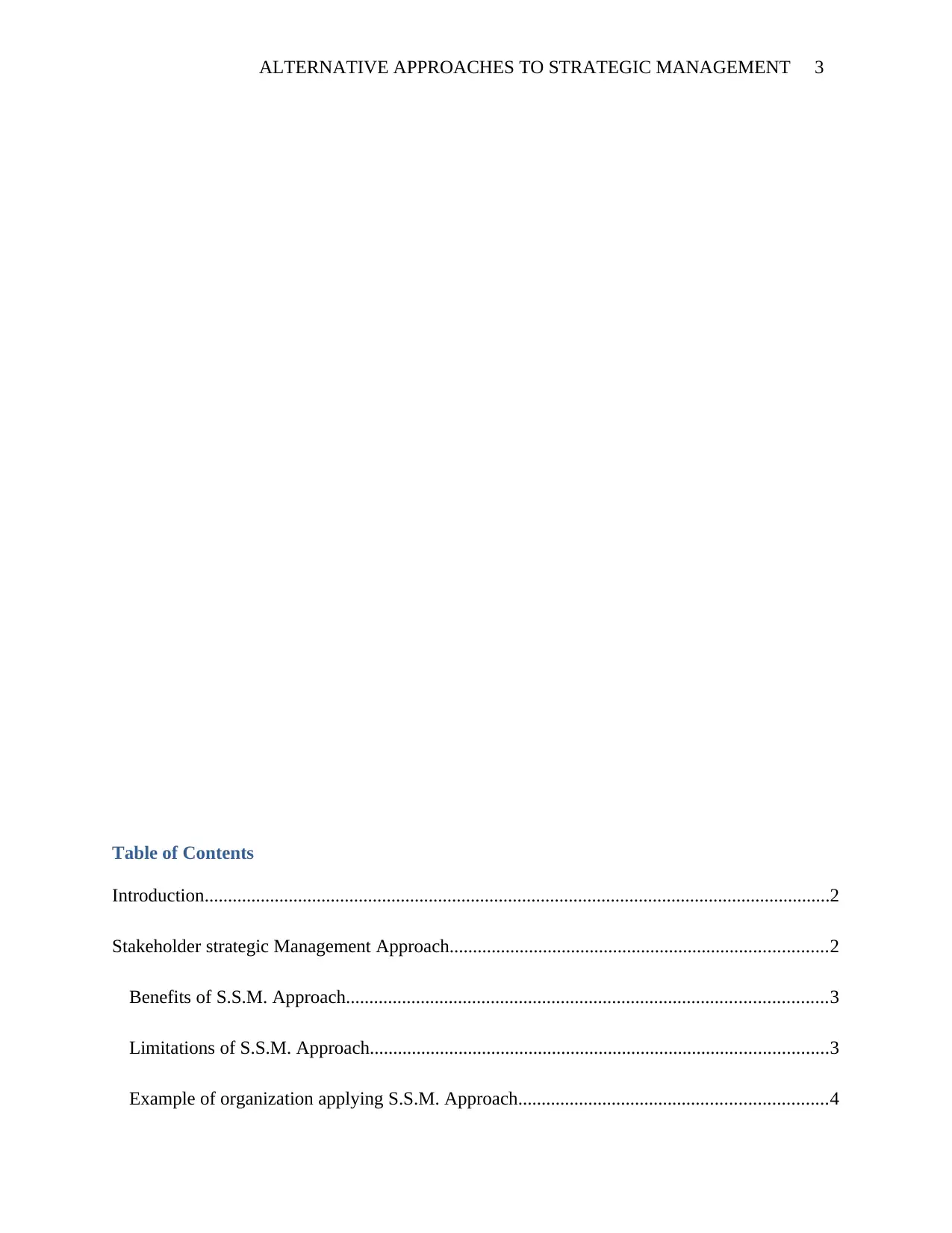
ALTERNATIVE APPROACHES TO STRATEGIC MANAGEMENT 3
Table of Contents
Introduction......................................................................................................................................2
Stakeholder strategic Management Approach.................................................................................2
Benefits of S.S.M. Approach.......................................................................................................3
Limitations of S.S.M. Approach..................................................................................................3
Example of organization applying S.S.M. Approach..................................................................4
Table of Contents
Introduction......................................................................................................................................2
Stakeholder strategic Management Approach.................................................................................2
Benefits of S.S.M. Approach.......................................................................................................3
Limitations of S.S.M. Approach..................................................................................................3
Example of organization applying S.S.M. Approach..................................................................4
⊘ This is a preview!⊘
Do you want full access?
Subscribe today to unlock all pages.

Trusted by 1+ million students worldwide
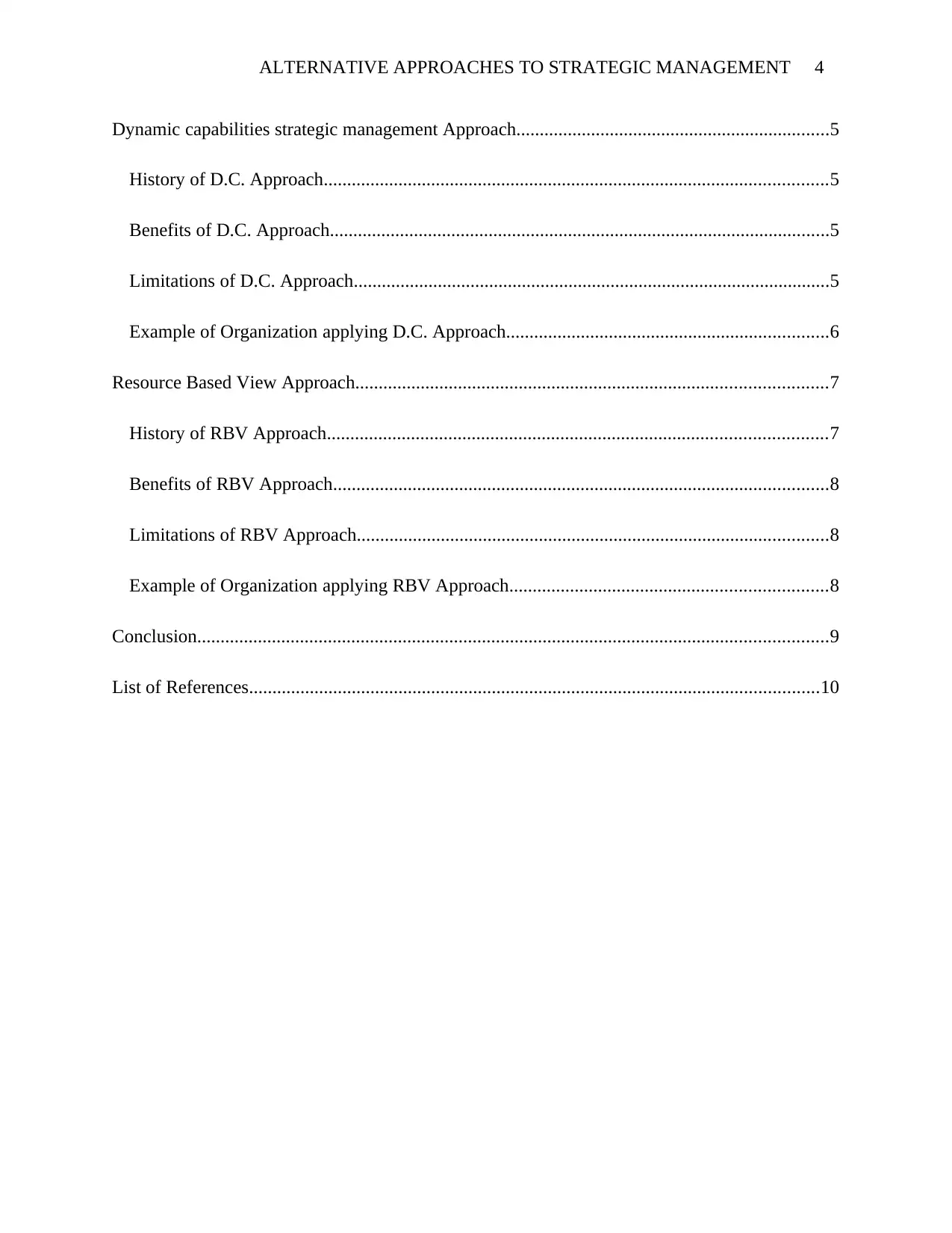
ALTERNATIVE APPROACHES TO STRATEGIC MANAGEMENT 4
Dynamic capabilities strategic management Approach...................................................................5
History of D.C. Approach............................................................................................................5
Benefits of D.C. Approach...........................................................................................................5
Limitations of D.C. Approach......................................................................................................5
Example of Organization applying D.C. Approach.....................................................................6
Resource Based View Approach.....................................................................................................7
History of RBV Approach...........................................................................................................7
Benefits of RBV Approach..........................................................................................................8
Limitations of RBV Approach.....................................................................................................8
Example of Organization applying RBV Approach....................................................................8
Conclusion.......................................................................................................................................9
List of References..........................................................................................................................10
Dynamic capabilities strategic management Approach...................................................................5
History of D.C. Approach............................................................................................................5
Benefits of D.C. Approach...........................................................................................................5
Limitations of D.C. Approach......................................................................................................5
Example of Organization applying D.C. Approach.....................................................................6
Resource Based View Approach.....................................................................................................7
History of RBV Approach...........................................................................................................7
Benefits of RBV Approach..........................................................................................................8
Limitations of RBV Approach.....................................................................................................8
Example of Organization applying RBV Approach....................................................................8
Conclusion.......................................................................................................................................9
List of References..........................................................................................................................10
Paraphrase This Document
Need a fresh take? Get an instant paraphrase of this document with our AI Paraphraser
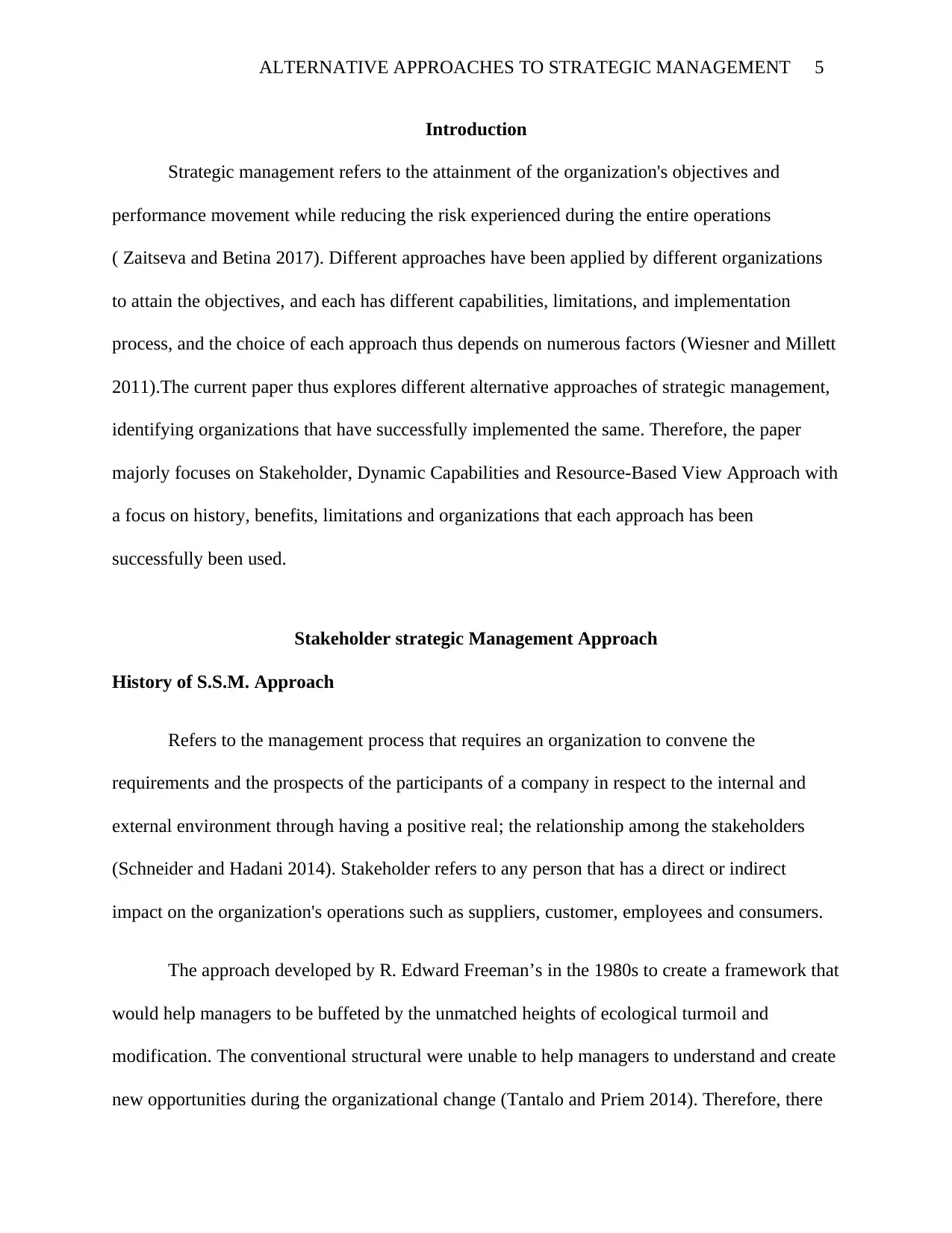
ALTERNATIVE APPROACHES TO STRATEGIC MANAGEMENT 5
Introduction
Strategic management refers to the attainment of the organization's objectives and
performance movement while reducing the risk experienced during the entire operations
( Zaitseva and Betina 2017). Different approaches have been applied by different organizations
to attain the objectives, and each has different capabilities, limitations, and implementation
process, and the choice of each approach thus depends on numerous factors (Wiesner and Millett
2011).The current paper thus explores different alternative approaches of strategic management,
identifying organizations that have successfully implemented the same. Therefore, the paper
majorly focuses on Stakeholder, Dynamic Capabilities and Resource-Based View Approach with
a focus on history, benefits, limitations and organizations that each approach has been
successfully been used.
Stakeholder strategic Management Approach
History of S.S.M. Approach
Refers to the management process that requires an organization to convene the
requirements and the prospects of the participants of a company in respect to the internal and
external environment through having a positive real; the relationship among the stakeholders
(Schneider and Hadani 2014). Stakeholder refers to any person that has a direct or indirect
impact on the organization's operations such as suppliers, customer, employees and consumers.
The approach developed by R. Edward Freeman’s in the 1980s to create a framework that
would help managers to be buffeted by the unmatched heights of ecological turmoil and
modification. The conventional structural were unable to help managers to understand and create
new opportunities during the organizational change (Tantalo and Priem 2014). Therefore, there
Introduction
Strategic management refers to the attainment of the organization's objectives and
performance movement while reducing the risk experienced during the entire operations
( Zaitseva and Betina 2017). Different approaches have been applied by different organizations
to attain the objectives, and each has different capabilities, limitations, and implementation
process, and the choice of each approach thus depends on numerous factors (Wiesner and Millett
2011).The current paper thus explores different alternative approaches of strategic management,
identifying organizations that have successfully implemented the same. Therefore, the paper
majorly focuses on Stakeholder, Dynamic Capabilities and Resource-Based View Approach with
a focus on history, benefits, limitations and organizations that each approach has been
successfully been used.
Stakeholder strategic Management Approach
History of S.S.M. Approach
Refers to the management process that requires an organization to convene the
requirements and the prospects of the participants of a company in respect to the internal and
external environment through having a positive real; the relationship among the stakeholders
(Schneider and Hadani 2014). Stakeholder refers to any person that has a direct or indirect
impact on the organization's operations such as suppliers, customer, employees and consumers.
The approach developed by R. Edward Freeman’s in the 1980s to create a framework that
would help managers to be buffeted by the unmatched heights of ecological turmoil and
modification. The conventional structural were unable to help managers to understand and create
new opportunities during the organizational change (Tantalo and Priem 2014). Therefore, there
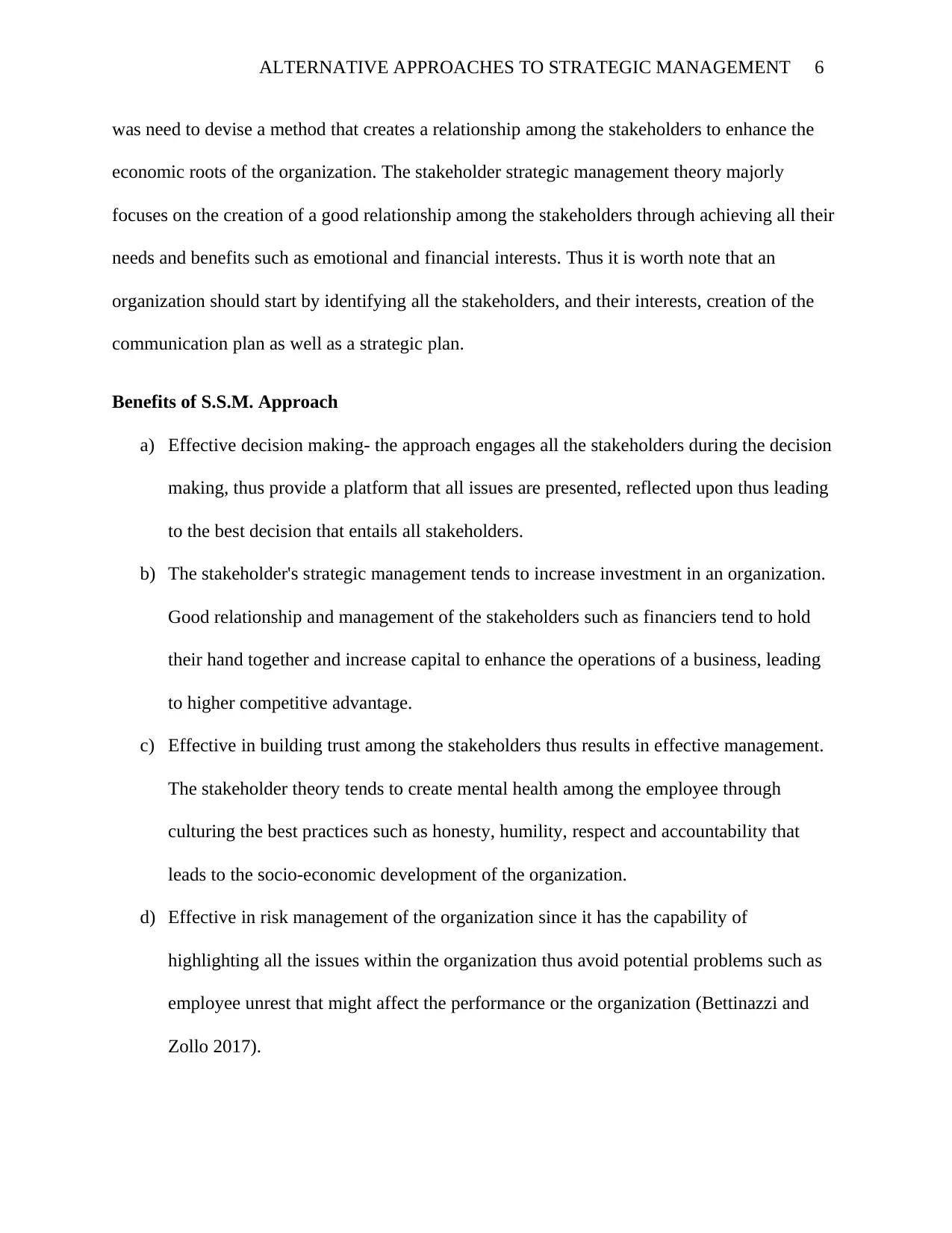
ALTERNATIVE APPROACHES TO STRATEGIC MANAGEMENT 6
was need to devise a method that creates a relationship among the stakeholders to enhance the
economic roots of the organization. The stakeholder strategic management theory majorly
focuses on the creation of a good relationship among the stakeholders through achieving all their
needs and benefits such as emotional and financial interests. Thus it is worth note that an
organization should start by identifying all the stakeholders, and their interests, creation of the
communication plan as well as a strategic plan.
Benefits of S.S.M. Approach
a) Effective decision making- the approach engages all the stakeholders during the decision
making, thus provide a platform that all issues are presented, reflected upon thus leading
to the best decision that entails all stakeholders.
b) The stakeholder's strategic management tends to increase investment in an organization.
Good relationship and management of the stakeholders such as financiers tend to hold
their hand together and increase capital to enhance the operations of a business, leading
to higher competitive advantage.
c) Effective in building trust among the stakeholders thus results in effective management.
The stakeholder theory tends to create mental health among the employee through
culturing the best practices such as honesty, humility, respect and accountability that
leads to the socio-economic development of the organization.
d) Effective in risk management of the organization since it has the capability of
highlighting all the issues within the organization thus avoid potential problems such as
employee unrest that might affect the performance or the organization (Bettinazzi and
Zollo 2017).
was need to devise a method that creates a relationship among the stakeholders to enhance the
economic roots of the organization. The stakeholder strategic management theory majorly
focuses on the creation of a good relationship among the stakeholders through achieving all their
needs and benefits such as emotional and financial interests. Thus it is worth note that an
organization should start by identifying all the stakeholders, and their interests, creation of the
communication plan as well as a strategic plan.
Benefits of S.S.M. Approach
a) Effective decision making- the approach engages all the stakeholders during the decision
making, thus provide a platform that all issues are presented, reflected upon thus leading
to the best decision that entails all stakeholders.
b) The stakeholder's strategic management tends to increase investment in an organization.
Good relationship and management of the stakeholders such as financiers tend to hold
their hand together and increase capital to enhance the operations of a business, leading
to higher competitive advantage.
c) Effective in building trust among the stakeholders thus results in effective management.
The stakeholder theory tends to create mental health among the employee through
culturing the best practices such as honesty, humility, respect and accountability that
leads to the socio-economic development of the organization.
d) Effective in risk management of the organization since it has the capability of
highlighting all the issues within the organization thus avoid potential problems such as
employee unrest that might affect the performance or the organization (Bettinazzi and
Zollo 2017).
⊘ This is a preview!⊘
Do you want full access?
Subscribe today to unlock all pages.

Trusted by 1+ million students worldwide
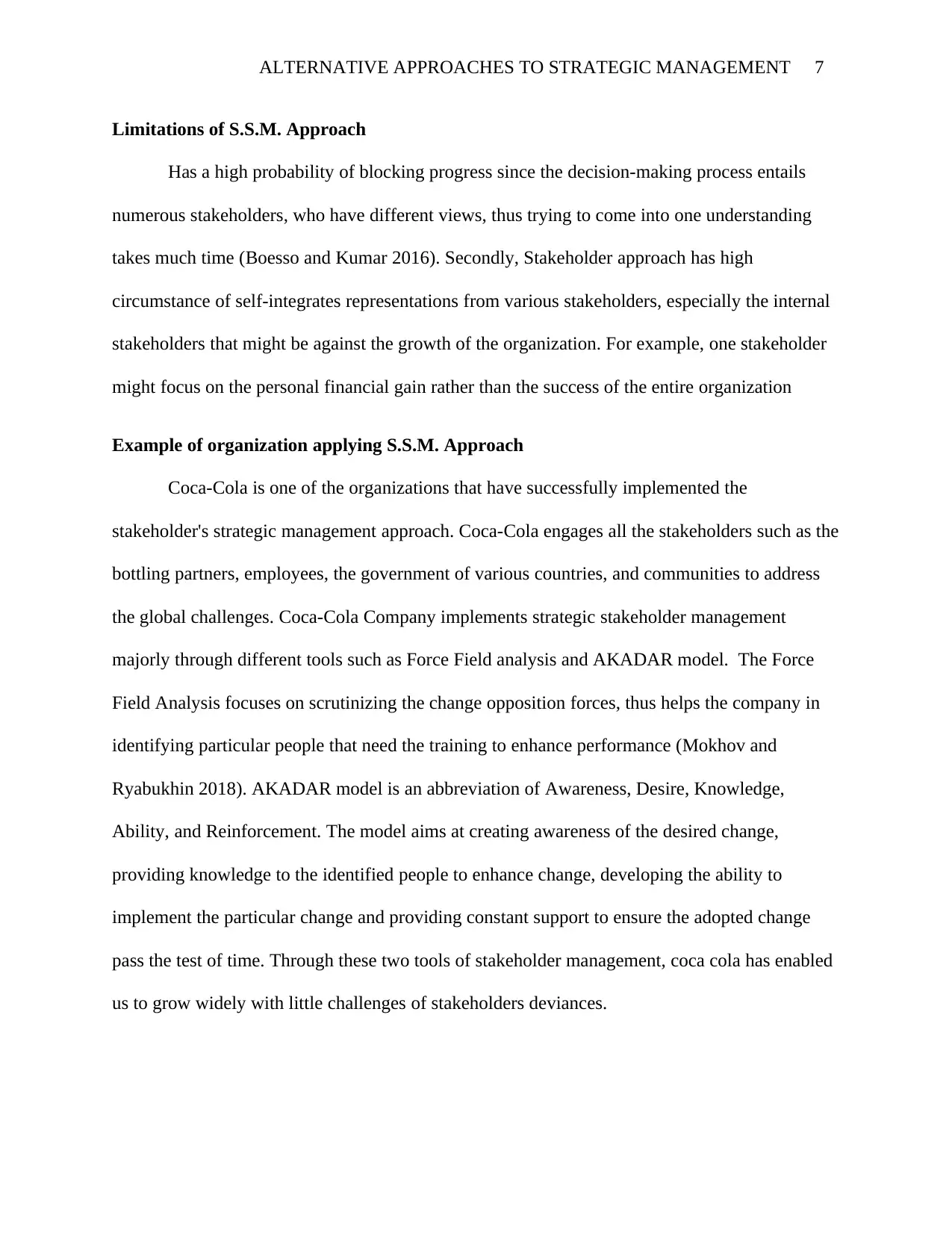
ALTERNATIVE APPROACHES TO STRATEGIC MANAGEMENT 7
Limitations of S.S.M. Approach
Has a high probability of blocking progress since the decision-making process entails
numerous stakeholders, who have different views, thus trying to come into one understanding
takes much time (Boesso and Kumar 2016). Secondly, Stakeholder approach has high
circumstance of self-integrates representations from various stakeholders, especially the internal
stakeholders that might be against the growth of the organization. For example, one stakeholder
might focus on the personal financial gain rather than the success of the entire organization
Example of organization applying S.S.M. Approach
Coca-Cola is one of the organizations that have successfully implemented the
stakeholder's strategic management approach. Coca-Cola engages all the stakeholders such as the
bottling partners, employees, the government of various countries, and communities to address
the global challenges. Coca-Cola Company implements strategic stakeholder management
majorly through different tools such as Force Field analysis and AKADAR model. The Force
Field Analysis focuses on scrutinizing the change opposition forces, thus helps the company in
identifying particular people that need the training to enhance performance (Mokhov and
Ryabukhin 2018). AKADAR model is an abbreviation of Awareness, Desire, Knowledge,
Ability, and Reinforcement. The model aims at creating awareness of the desired change,
providing knowledge to the identified people to enhance change, developing the ability to
implement the particular change and providing constant support to ensure the adopted change
pass the test of time. Through these two tools of stakeholder management, coca cola has enabled
us to grow widely with little challenges of stakeholders deviances.
Limitations of S.S.M. Approach
Has a high probability of blocking progress since the decision-making process entails
numerous stakeholders, who have different views, thus trying to come into one understanding
takes much time (Boesso and Kumar 2016). Secondly, Stakeholder approach has high
circumstance of self-integrates representations from various stakeholders, especially the internal
stakeholders that might be against the growth of the organization. For example, one stakeholder
might focus on the personal financial gain rather than the success of the entire organization
Example of organization applying S.S.M. Approach
Coca-Cola is one of the organizations that have successfully implemented the
stakeholder's strategic management approach. Coca-Cola engages all the stakeholders such as the
bottling partners, employees, the government of various countries, and communities to address
the global challenges. Coca-Cola Company implements strategic stakeholder management
majorly through different tools such as Force Field analysis and AKADAR model. The Force
Field Analysis focuses on scrutinizing the change opposition forces, thus helps the company in
identifying particular people that need the training to enhance performance (Mokhov and
Ryabukhin 2018). AKADAR model is an abbreviation of Awareness, Desire, Knowledge,
Ability, and Reinforcement. The model aims at creating awareness of the desired change,
providing knowledge to the identified people to enhance change, developing the ability to
implement the particular change and providing constant support to ensure the adopted change
pass the test of time. Through these two tools of stakeholder management, coca cola has enabled
us to grow widely with little challenges of stakeholders deviances.
Paraphrase This Document
Need a fresh take? Get an instant paraphrase of this document with our AI Paraphraser
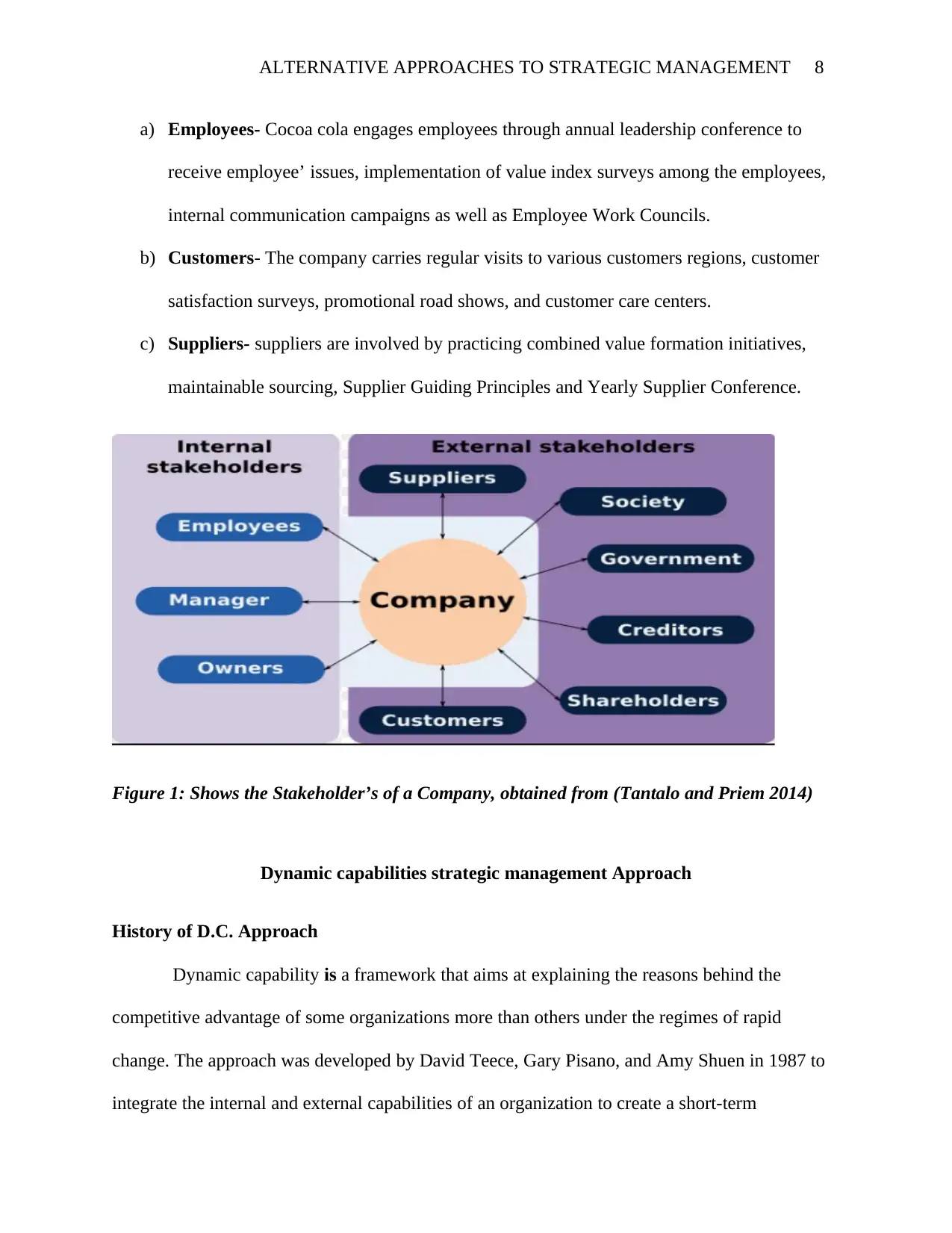
ALTERNATIVE APPROACHES TO STRATEGIC MANAGEMENT 8
a) Employees- Cocoa cola engages employees through annual leadership conference to
receive employee’ issues, implementation of value index surveys among the employees,
internal communication campaigns as well as Employee Work Councils.
b) Customers- The company carries regular visits to various customers regions, customer
satisfaction surveys, promotional road shows, and customer care centers.
c) Suppliers- suppliers are involved by practicing combined value formation initiatives,
maintainable sourcing, Supplier Guiding Principles and Yearly Supplier Conference.
Figure 1: Shows the Stakeholder’s of a Company, obtained from (Tantalo and Priem 2014)
Dynamic capabilities strategic management Approach
History of D.C. Approach
Dynamic capability is a framework that aims at explaining the reasons behind the
competitive advantage of some organizations more than others under the regimes of rapid
change. The approach was developed by David Teece, Gary Pisano, and Amy Shuen in 1987 to
integrate the internal and external capabilities of an organization to create a short-term
a) Employees- Cocoa cola engages employees through annual leadership conference to
receive employee’ issues, implementation of value index surveys among the employees,
internal communication campaigns as well as Employee Work Councils.
b) Customers- The company carries regular visits to various customers regions, customer
satisfaction surveys, promotional road shows, and customer care centers.
c) Suppliers- suppliers are involved by practicing combined value formation initiatives,
maintainable sourcing, Supplier Guiding Principles and Yearly Supplier Conference.
Figure 1: Shows the Stakeholder’s of a Company, obtained from (Tantalo and Priem 2014)
Dynamic capabilities strategic management Approach
History of D.C. Approach
Dynamic capability is a framework that aims at explaining the reasons behind the
competitive advantage of some organizations more than others under the regimes of rapid
change. The approach was developed by David Teece, Gary Pisano, and Amy Shuen in 1987 to
integrate the internal and external capabilities of an organization to create a short-term
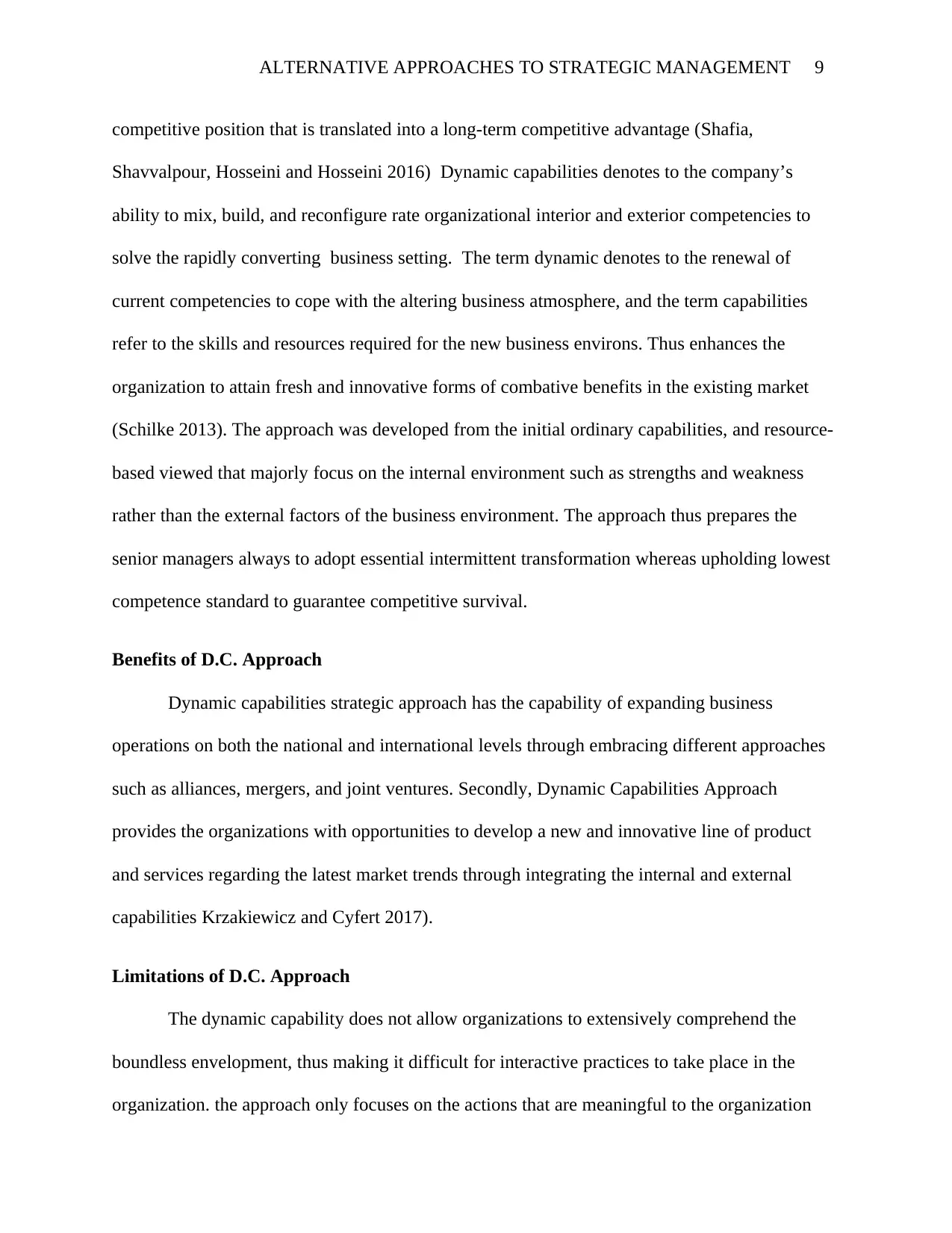
ALTERNATIVE APPROACHES TO STRATEGIC MANAGEMENT 9
competitive position that is translated into a long-term competitive advantage (Shafia,
Shavvalpour, Hosseini and Hosseini 2016) Dynamic capabilities denotes to the company’s
ability to mix, build, and reconfigure rate organizational interior and exterior competencies to
solve the rapidly converting business setting. The term dynamic denotes to the renewal of
current competencies to cope with the altering business atmosphere, and the term capabilities
refer to the skills and resources required for the new business environs. Thus enhances the
organization to attain fresh and innovative forms of combative benefits in the existing market
(Schilke 2013). The approach was developed from the initial ordinary capabilities, and resource-
based viewed that majorly focus on the internal environment such as strengths and weakness
rather than the external factors of the business environment. The approach thus prepares the
senior managers always to adopt essential intermittent transformation whereas upholding lowest
competence standard to guarantee competitive survival.
Benefits of D.C. Approach
Dynamic capabilities strategic approach has the capability of expanding business
operations on both the national and international levels through embracing different approaches
such as alliances, mergers, and joint ventures. Secondly, Dynamic Capabilities Approach
provides the organizations with opportunities to develop a new and innovative line of product
and services regarding the latest market trends through integrating the internal and external
capabilities Krzakiewicz and Cyfert 2017).
Limitations of D.C. Approach
The dynamic capability does not allow organizations to extensively comprehend the
boundless envelopment, thus making it difficult for interactive practices to take place in the
organization. the approach only focuses on the actions that are meaningful to the organization
competitive position that is translated into a long-term competitive advantage (Shafia,
Shavvalpour, Hosseini and Hosseini 2016) Dynamic capabilities denotes to the company’s
ability to mix, build, and reconfigure rate organizational interior and exterior competencies to
solve the rapidly converting business setting. The term dynamic denotes to the renewal of
current competencies to cope with the altering business atmosphere, and the term capabilities
refer to the skills and resources required for the new business environs. Thus enhances the
organization to attain fresh and innovative forms of combative benefits in the existing market
(Schilke 2013). The approach was developed from the initial ordinary capabilities, and resource-
based viewed that majorly focus on the internal environment such as strengths and weakness
rather than the external factors of the business environment. The approach thus prepares the
senior managers always to adopt essential intermittent transformation whereas upholding lowest
competence standard to guarantee competitive survival.
Benefits of D.C. Approach
Dynamic capabilities strategic approach has the capability of expanding business
operations on both the national and international levels through embracing different approaches
such as alliances, mergers, and joint ventures. Secondly, Dynamic Capabilities Approach
provides the organizations with opportunities to develop a new and innovative line of product
and services regarding the latest market trends through integrating the internal and external
capabilities Krzakiewicz and Cyfert 2017).
Limitations of D.C. Approach
The dynamic capability does not allow organizations to extensively comprehend the
boundless envelopment, thus making it difficult for interactive practices to take place in the
organization. the approach only focuses on the actions that are meaningful to the organization
⊘ This is a preview!⊘
Do you want full access?
Subscribe today to unlock all pages.

Trusted by 1+ million students worldwide
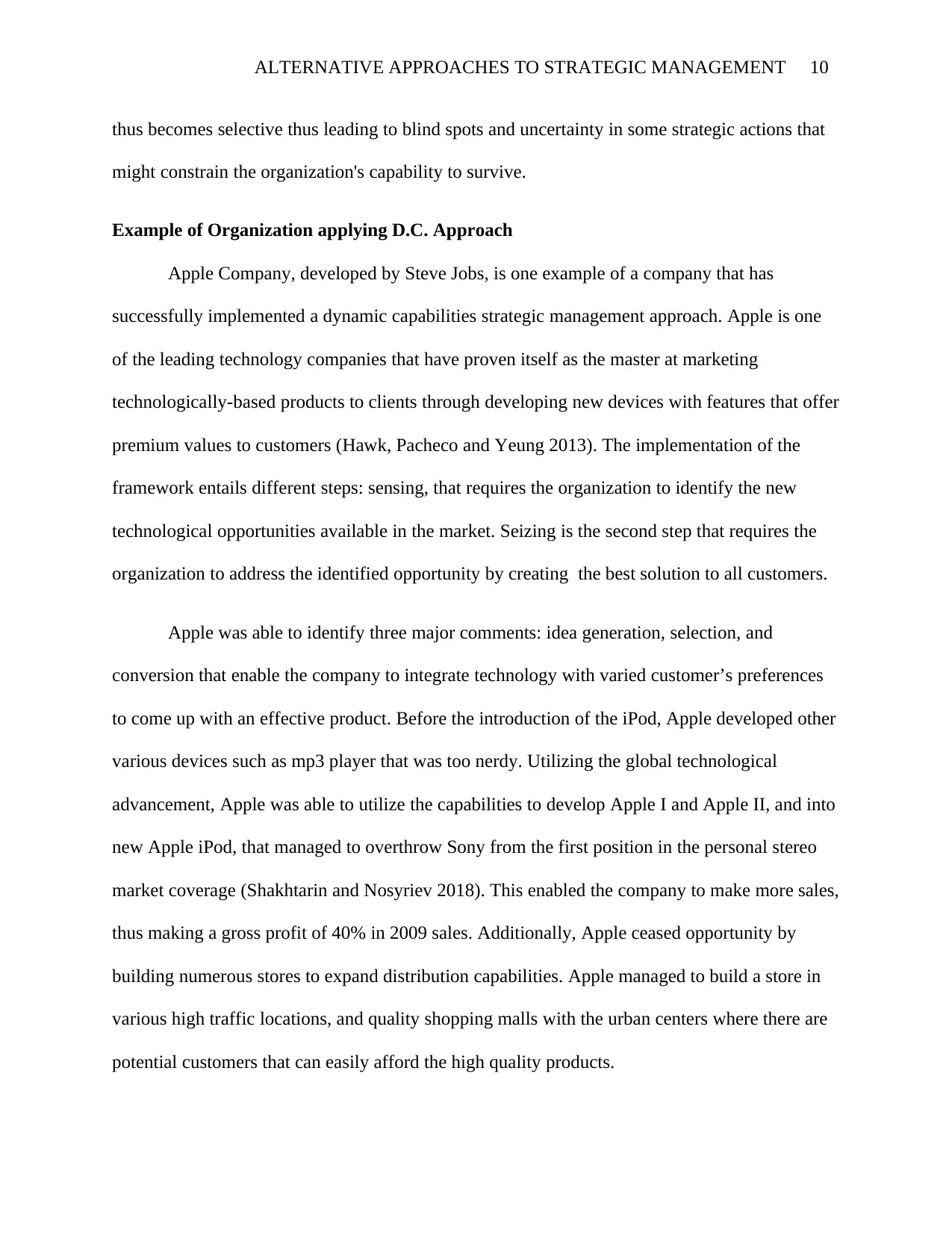
ALTERNATIVE APPROACHES TO STRATEGIC MANAGEMENT 10
thus becomes selective thus leading to blind spots and uncertainty in some strategic actions that
might constrain the organization's capability to survive.
Example of Organization applying D.C. Approach
Apple Company, developed by Steve Jobs, is one example of a company that has
successfully implemented a dynamic capabilities strategic management approach. Apple is one
of the leading technology companies that have proven itself as the master at marketing
technologically-based products to clients through developing new devices with features that offer
premium values to customers (Hawk, Pacheco and Yeung 2013). The implementation of the
framework entails different steps: sensing, that requires the organization to identify the new
technological opportunities available in the market. Seizing is the second step that requires the
organization to address the identified opportunity by creating the best solution to all customers.
Apple was able to identify three major comments: idea generation, selection, and
conversion that enable the company to integrate technology with varied customer’s preferences
to come up with an effective product. Before the introduction of the iPod, Apple developed other
various devices such as mp3 player that was too nerdy. Utilizing the global technological
advancement, Apple was able to utilize the capabilities to develop Apple I and Apple II, and into
new Apple iPod, that managed to overthrow Sony from the first position in the personal stereo
market coverage (Shakhtarіn and Nosyriev 2018). This enabled the company to make more sales,
thus making a gross profit of 40% in 2009 sales. Additionally, Apple ceased opportunity by
building numerous stores to expand distribution capabilities. Apple managed to build a store in
various high traffic locations, and quality shopping malls with the urban centers where there are
potential customers that can easily afford the high quality products.
thus becomes selective thus leading to blind spots and uncertainty in some strategic actions that
might constrain the organization's capability to survive.
Example of Organization applying D.C. Approach
Apple Company, developed by Steve Jobs, is one example of a company that has
successfully implemented a dynamic capabilities strategic management approach. Apple is one
of the leading technology companies that have proven itself as the master at marketing
technologically-based products to clients through developing new devices with features that offer
premium values to customers (Hawk, Pacheco and Yeung 2013). The implementation of the
framework entails different steps: sensing, that requires the organization to identify the new
technological opportunities available in the market. Seizing is the second step that requires the
organization to address the identified opportunity by creating the best solution to all customers.
Apple was able to identify three major comments: idea generation, selection, and
conversion that enable the company to integrate technology with varied customer’s preferences
to come up with an effective product. Before the introduction of the iPod, Apple developed other
various devices such as mp3 player that was too nerdy. Utilizing the global technological
advancement, Apple was able to utilize the capabilities to develop Apple I and Apple II, and into
new Apple iPod, that managed to overthrow Sony from the first position in the personal stereo
market coverage (Shakhtarіn and Nosyriev 2018). This enabled the company to make more sales,
thus making a gross profit of 40% in 2009 sales. Additionally, Apple ceased opportunity by
building numerous stores to expand distribution capabilities. Apple managed to build a store in
various high traffic locations, and quality shopping malls with the urban centers where there are
potential customers that can easily afford the high quality products.
Paraphrase This Document
Need a fresh take? Get an instant paraphrase of this document with our AI Paraphraser
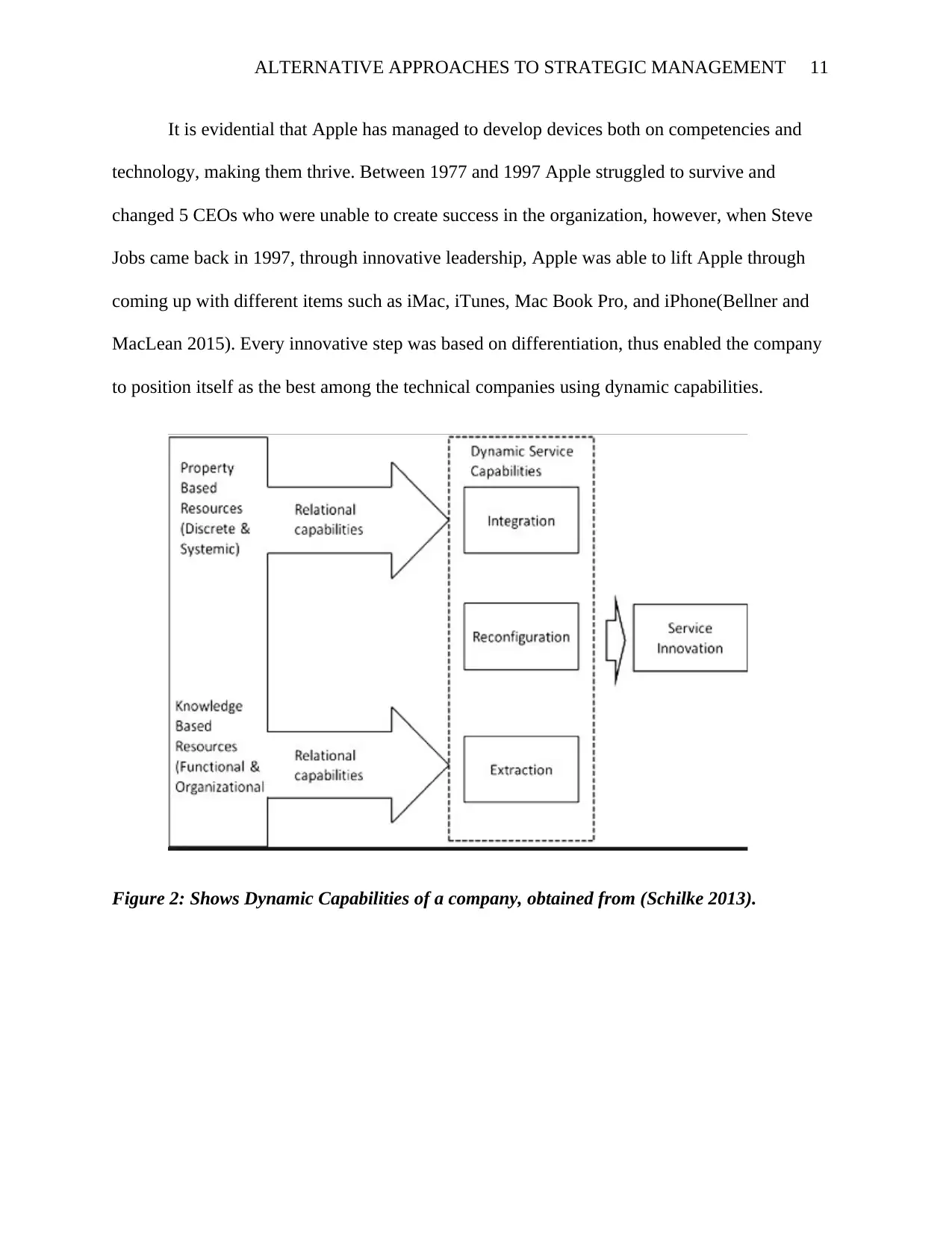
ALTERNATIVE APPROACHES TO STRATEGIC MANAGEMENT 11
It is evidential that Apple has managed to develop devices both on competencies and
technology, making them thrive. Between 1977 and 1997 Apple struggled to survive and
changed 5 CEOs who were unable to create success in the organization, however, when Steve
Jobs came back in 1997, through innovative leadership, Apple was able to lift Apple through
coming up with different items such as iMac, iTunes, Mac Book Pro, and iPhone(Bellner and
MacLean 2015). Every innovative step was based on differentiation, thus enabled the company
to position itself as the best among the technical companies using dynamic capabilities.
Figure 2: Shows Dynamic Capabilities of a company, obtained from (Schilke 2013).
It is evidential that Apple has managed to develop devices both on competencies and
technology, making them thrive. Between 1977 and 1997 Apple struggled to survive and
changed 5 CEOs who were unable to create success in the organization, however, when Steve
Jobs came back in 1997, through innovative leadership, Apple was able to lift Apple through
coming up with different items such as iMac, iTunes, Mac Book Pro, and iPhone(Bellner and
MacLean 2015). Every innovative step was based on differentiation, thus enabled the company
to position itself as the best among the technical companies using dynamic capabilities.
Figure 2: Shows Dynamic Capabilities of a company, obtained from (Schilke 2013).
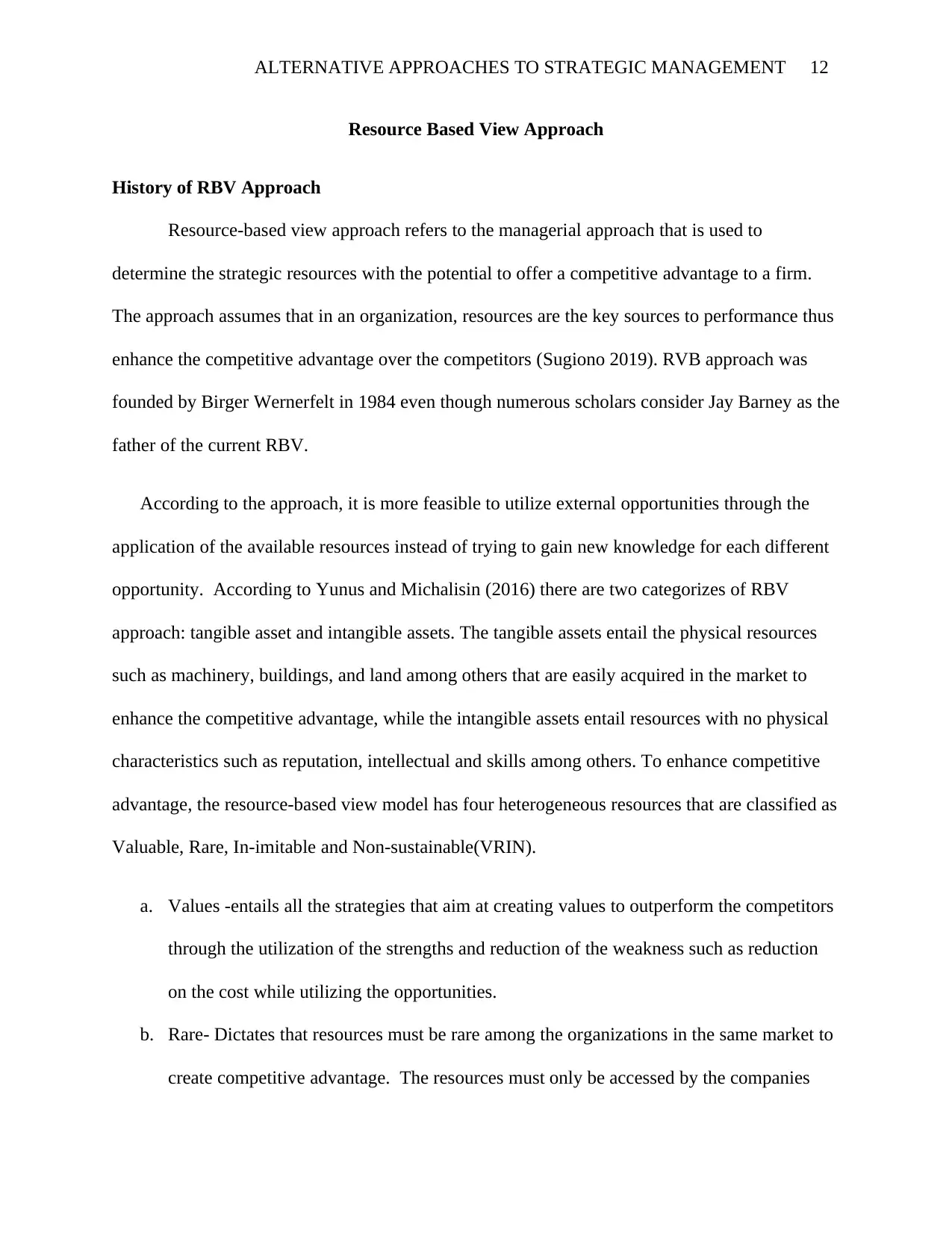
ALTERNATIVE APPROACHES TO STRATEGIC MANAGEMENT 12
Resource Based View Approach
History of RBV Approach
Resource-based view approach refers to the managerial approach that is used to
determine the strategic resources with the potential to offer a competitive advantage to a firm.
The approach assumes that in an organization, resources are the key sources to performance thus
enhance the competitive advantage over the competitors (Sugiono 2019). RVB approach was
founded by Birger Wernerfelt in 1984 even though numerous scholars consider Jay Barney as the
father of the current RBV.
According to the approach, it is more feasible to utilize external opportunities through the
application of the available resources instead of trying to gain new knowledge for each different
opportunity. According to Yunus and Michalisin (2016) there are two categorizes of RBV
approach: tangible asset and intangible assets. The tangible assets entail the physical resources
such as machinery, buildings, and land among others that are easily acquired in the market to
enhance the competitive advantage, while the intangible assets entail resources with no physical
characteristics such as reputation, intellectual and skills among others. To enhance competitive
advantage, the resource-based view model has four heterogeneous resources that are classified as
Valuable, Rare, In-imitable and Non-sustainable(VRIN).
a. Values -entails all the strategies that aim at creating values to outperform the competitors
through the utilization of the strengths and reduction of the weakness such as reduction
on the cost while utilizing the opportunities.
b. Rare- Dictates that resources must be rare among the organizations in the same market to
create competitive advantage. The resources must only be accessed by the companies
Resource Based View Approach
History of RBV Approach
Resource-based view approach refers to the managerial approach that is used to
determine the strategic resources with the potential to offer a competitive advantage to a firm.
The approach assumes that in an organization, resources are the key sources to performance thus
enhance the competitive advantage over the competitors (Sugiono 2019). RVB approach was
founded by Birger Wernerfelt in 1984 even though numerous scholars consider Jay Barney as the
father of the current RBV.
According to the approach, it is more feasible to utilize external opportunities through the
application of the available resources instead of trying to gain new knowledge for each different
opportunity. According to Yunus and Michalisin (2016) there are two categorizes of RBV
approach: tangible asset and intangible assets. The tangible assets entail the physical resources
such as machinery, buildings, and land among others that are easily acquired in the market to
enhance the competitive advantage, while the intangible assets entail resources with no physical
characteristics such as reputation, intellectual and skills among others. To enhance competitive
advantage, the resource-based view model has four heterogeneous resources that are classified as
Valuable, Rare, In-imitable and Non-sustainable(VRIN).
a. Values -entails all the strategies that aim at creating values to outperform the competitors
through the utilization of the strengths and reduction of the weakness such as reduction
on the cost while utilizing the opportunities.
b. Rare- Dictates that resources must be rare among the organizations in the same market to
create competitive advantage. The resources must only be accessed by the companies
⊘ This is a preview!⊘
Do you want full access?
Subscribe today to unlock all pages.

Trusted by 1+ million students worldwide
1 out of 19
Related Documents
Your All-in-One AI-Powered Toolkit for Academic Success.
+13062052269
info@desklib.com
Available 24*7 on WhatsApp / Email
![[object Object]](/_next/static/media/star-bottom.7253800d.svg)
Unlock your academic potential
Copyright © 2020–2025 A2Z Services. All Rights Reserved. Developed and managed by ZUCOL.





